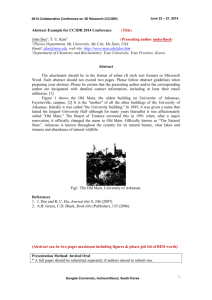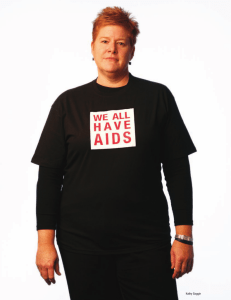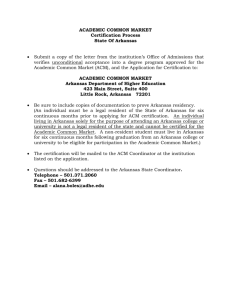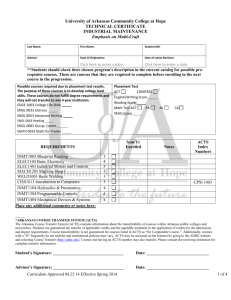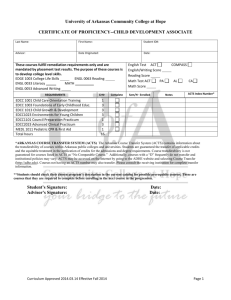Curriculum Vitae: - Department of Entomology
advertisement
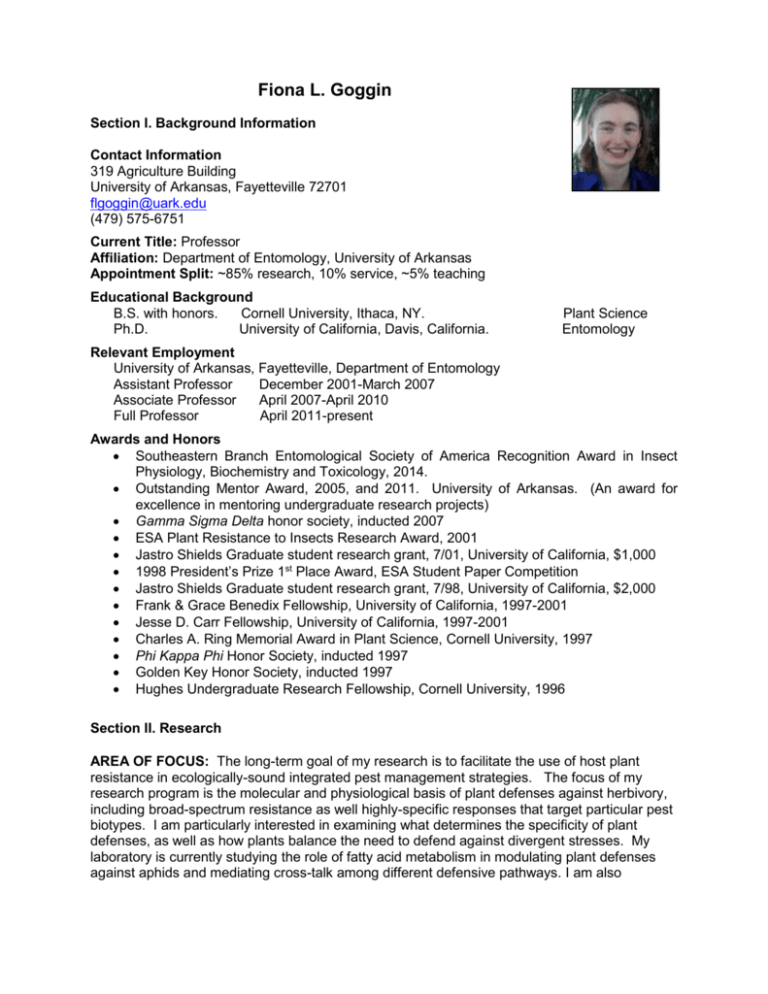
Fiona L. Goggin Section I. Background Information Contact Information 319 Agriculture Building University of Arkansas, Fayetteville 72701 flgoggin@uark.edu (479) 575-6751 Current Title: Professor Affiliation: Department of Entomology, University of Arkansas Appointment Split: ~85% research, 10% service, ~5% teaching Educational Background B.S. with honors. Cornell University, Ithaca, NY. Ph.D. University of California, Davis, California. Plant Science Entomology Relevant Employment University of Arkansas, Fayetteville, Department of Entomology Assistant Professor December 2001-March 2007 Associate Professor April 2007-April 2010 Full Professor April 2011-present Awards and Honors Southeastern Branch Entomological Society of America Recognition Award in Insect Physiology, Biochemistry and Toxicology, 2014. Outstanding Mentor Award, 2005, and 2011. University of Arkansas. (An award for excellence in mentoring undergraduate research projects) Gamma Sigma Delta honor society, inducted 2007 ESA Plant Resistance to Insects Research Award, 2001 Jastro Shields Graduate student research grant, 7/01, University of California, $1,000 1998 President’s Prize 1st Place Award, ESA Student Paper Competition Jastro Shields Graduate student research grant, 7/98, University of California, $2,000 Frank & Grace Benedix Fellowship, University of California, 1997-2001 Jesse D. Carr Fellowship, University of California, 1997-2001 Charles A. Ring Memorial Award in Plant Science, Cornell University, 1997 Phi Kappa Phi Honor Society, inducted 1997 Golden Key Honor Society, inducted 1997 Hughes Undergraduate Research Fellowship, Cornell University, 1996 Section II. Research AREA OF FOCUS: The long-term goal of my research is to facilitate the use of host plant resistance in ecologically-sound integrated pest management strategies. The focus of my research program is the molecular and physiological basis of plant defenses against herbivory, including broad-spectrum resistance as well highly-specific responses that target particular pest biotypes. I am particularly interested in examining what determines the specificity of plant defenses, as well as how plants balance the need to defend against divergent stresses. My laboratory is currently studying the role of fatty acid metabolism in modulating plant defenses against aphids and mediating cross-talk among different defensive pathways. I am also interested in the impact of plant defenses on multi-trophic interactions; for example, I have examined the impact of host plant resistance on aphid endosymbionts and natural enemies. IIAi. Peer-Reviewed Publications (26 in print) Invited Reviews (2) Goggin F. L., Avila, C. A.1, and Lorence, A. 2010. Vitamin C content in plants is modified by insects and influences susceptibility to herbivory. BioEssays, 32:777-790. BioEssays publishes reviews and commentaries in the areas of cellular and molecular biology, genetics, and physiology, with an emphasis on transdisciplinary and integrative biology (Impact Factor: 5.3). Goggin, F. L. 2007. Plant-aphid interactions: molecular and ecological perspectives. Current Opinion in Plant Biology 10: 399-408. COPB publishes reviews on all aspects of plant biology and biotic interactions (Impact Factor: 10.3). Other Peer-reviewed Research Articles (24) Avila, C.A. 1, Arevalo-Soliz, M.A.2, Lorence, A., and Goggin, F.L. 2013. Expression of αDIOXYGENASE 1 in tomato and Arabidopsis contributes to plant defenses against aphids. Molecular Plant Microbe Interactions, 26(8):977-86. Avila, C.A.1, Arévalo-Soliz2, L.M., Jia, L.1 , Navarre, D.A., Chen, Z.1 , Howe, G.A., Meng, Q.W., E. Smith, J.E., and Goggin, F.L. 2012. Loss of function of FATTY ACID DESATURASE 7 in tomato enhances basal aphid resistance in a salicylate-dependent manner. Plant Physiology, 158: 2028-2041. http://0www.plantphysiol.org.library.uark.edu/content/158/4/2028.full?sid=3650ffc4-48b7-48c3a743-63b128dab4fb Sayler, R.J., Walker, C.3, Goggin, F.L., Agudelo, P., and Kirkpatrick, T. 2012. Conventional PCR Detection and Real-Time PCR Quantification of Reniform Nematodes. Plant Disease, Vol. 96 No. 12. 1757- 1762. Tran, H.4, Stephenson, S.L., Chen, Z.1, Pollock, E., and Goggin, F.L. 2012. Evaluating the potential use of myxomycetes as a source of lipids for biodiesel production. Bioresource Technology, 123: 386-389. Corbett, B.P., Jia, L.1, Sayler, R.J., Arevalo-Soliz L.M2, and Goggin, F.L. 2011. The Effects of Root-knot Nematode Infection and Mi-mediated Nematode Resistance in Tomato on Plant Fitness. Journal of Nematology, 43 (2): 82-89. Wu, C. 1, Jia, L. 1, and Goggin, F.L. The reliability of TRV-based VIGS experiments in tomato is influenced by the size of the vector control. Molecular Plant Pathology, 12(3), 299-305. Palliparrambil, R.3, Reese, J., Avila, C. 1, Louis, J., & Goggin, F. L. 2010. Mi-mediated aphid resistance in tomato: tissue localization and impact on the feeding behavior of two potato aphid clones with differing levels of virulence. Entomologia Experimentalis et Applicata 135: 295-307. Francis, F., Guillonneau, F., Leprince, P., De Pauw, E., Haubruge, E., Jia, L. 1, and Goggin, F. L. 2010. Tritrophic interactions among Macrosiphum euphorbiae aphids, their host plants and endosymbionts: investigation by a proteomic approach. Journal of Insect Physiology 56: 575-585. 1 Postdoctoral associate or other research associate in my laboratory. Graduate student in the Goggin lab 3 Undergraduate student advised or co-advised by Dr. Goggin 4 Fulbright scholar who visited the Goggin laboratory to learn and conduct lipid analyses. 2 5 Suza, W. P., Avila, C.A. 1, Carruthers, K. 2, Kulkarni, S., Goggin, F. L., and Lorence, A. 2010. Exploring the impact of wounding and jasmonates on ascorbate metabolism. Plant Physiology and Biochemistry 48: 337-350. Anstead, J., Samuel, P., Song, N., Wu, C. 1, Thompson G. A., and Goggin F. L. 2010. Activation of ethylene-related genes in response to aphid feeding on resistant and susceptible melon and tomato plants. Entomologia Experimentalis et Applicata 134: 170181. Muilenburg, V. L. 5, Goggin, F. L., Hebert, S. 2, Jia, L. 3, and Stephen, F. M. 2008. Ant predation on red oak borer confirmed by field observation and DNA analysis. Agricultural and Forest Entomology 10: 205-213. Hebert, S.2, Jia, L. 1, and Goggin, F. L. 2007. Quantitative differences in aphid virulence and foliar symptom development on tomato plants carrying the Mi resistance gene. Environmental Entomology 36: 458-467. Sagers, C. L., and Goggin, F. L. 2007. Isotopic enrichment in a phloem-feeding insect: influences of nutrient and water availability. Oecologia 151: 464-472. Goggin, F. L., Jia, L. 1, Shah, G., Hebert, S. 2, Williamson, V. M., and Ullman, D. E. 2006. The tomato Mi-1.2 herbivore resistance gene functions to confer nematode resistance but not aphid resistance in eggplant. Molecular Plant-Microbe Interactions 19: 383-388. Thompson, G. T., and Goggin, F. L. 2006. Transcriptomics and functional genomics of plant defense induction by phloem-feeding insects. Journal of Experimental Botany 57: 755-766. Korth, K. L., Doege, S. J., Park S., Goggin, F. L., Wang, Q., Gomez, S. K., Liu, G., Jia, L. 1, and Nakata, P. A. 2006. Medicago truncatula mutants demonstrate the role of plant calcium oxalate crystals as an effective defense against chewing insects. Plant Physiology 141: 188-195. Cooper, W. R.2, Jia, L. 1, and Goggin, F. L. 2005. Effects of jasmonate-induced defenses on root-knot nematode infection of resistant and susceptible tomato cultivars. Journal of Chemical Ecology 31: 1953-1967. Cooper, W. R.2, and Goggin, F. L. 2005. The impact of jasmonate-dependent defenses on the feeding behavior, fecundity, and mortality of the potato aphid, Macrosiphum euphorbiae. Entomologia Experimentalis et Applicata 115: 107-115. Cooper, W. R.2, Jia, L. 1, and Goggin, F. L. 2004. Acquired and R-gene-mediated resistance against the potato aphid in tomato. Journal of Chemical Ecology 30: 25272542. Goggin, F. L., Shah, G., Williamson, V. M., and Ullman, D. E. 2004. Instability of Mimediated nematode resistance in transgenic tomato plants. Molecular Breeding 13: 391394. Goggin, F.L., Shah, G., Williamson, V. M., and Ullman, D. E. 2004. Developmental regulation of Mi-mediated aphid resistance is independent of Mi-1.2 transcript levels. Molecular Plant-Microbe Interactions 17: 532-536. Goggin, F.L., Williamson, V. M., and Ullman, D. E. 2001. Variability in the response of Macrosiphum euphorbiae and Myzus persicae (Hemiptera: Aphididae) to the tomato resistance gene Mi. Environmental Entomology 30: 101-106. Goggin, F. L., Medville R., and Turgeon, R. 2001. Phloem loading in the tulip tree. Mechanisms and evolutionary implications. Plant Physiology 124: 891-899. Graduate student co-advised in my laboratory. Rossi, M., Goggin, F. L., Milligan, S. B., Kaloshian, I., Ullman, D. E., and Williamson, V. M. 1998. The nematode resistance gene Mi of tomato confers resistance against the potato aphid. Proceedings of the National Academy of Science, U.S.A. 95: 9750-9754. IIAii. Other Research Publications (1) Corbett, B. P. 4, and Goggin, F. L. 2007. The effects of nematode infection and Mimediated resistance in tomato (Solanum lycopersicum) on plant fitness. Inquiry 8:3-9. (the University of Arkansas undergraduate research journal. IIB. Research Support (>$1.9 million in competitive funding since 2003) Arkansas Soybean Promotion Board. 4/2014-3/2015. Use of a Plant Elicitor Peptide for Broad-spectrum Nematode Resistance in Soybean. My role: principal investigator. Collaborator: Alisa Huffaker. My share: $36,000. Eligible for 2-year renewal. NSF. Total: $637,448. 4/2010-3/2014. Influence of fatty acid desaturation on plant defenses against aphids. My Role: sole investigator. NSF-EPSCoR. Total: $249,978. My share: $124,268. 5/08-3/10. Intersection of Ascorbate regulation, jasmonate signaling and defense against herbivory in plants. My role: This grant is shared equally between two co-principal investigators (co-PIs), myself and Argelia Lorence (Arkansas State University). NSF-EPSCoR: Total: $249,952. My share: $132,557. 10/08-3/10. Role of oxylipins in plant defenses against aphids. My Role: principal investigator. Co-PI = Robyn Hannigan (Arkansas State University). USDA-NRI. $346,193. 11/05-11/08. Comparative analysis of aphid resistance in tomato & melon. My role: principal investigator. Collaborator = Gary Thompson, Oklahoma State University. USDA-NRI. $99,967. 11/04-11/07. Transcriptional responses to aphid feeding in tomato. My role: sole investigator. Arkansas Biotechnology Institute, $317,937 ($147,200 in research support; $170,737 in support for my salary). 7/05-7/08. Regulation of antioxidants in tomato by the jasmonate pathway. My role: sole investigator. California Tomato Commission, $41,407. 5/04-5/06. Integrated aphid and nematode management in tomato. My role: sole investigator. Arkansas Experiment Station, $10,000. 4/05-4/06. Role of Spr2, a fatty acid desaturase in tomato, in regulating plant defenses against herbivores. My role: sole investigator. Arkansas Experiment Station, $20,000. 4/03-4/05. Mechanisms of aphid and nematode resistance in tomato. My role: sole investigator. IIC. Graduate students and postdoctoral associates trained Masters students: 2 (graduated) PhD students: 4 (3 graduated; 1 current) Postdoctoral associates: 4 (2 previous; 2 current) IIDi. Invited Research Talks (>30 since 2000, including 11 at international meetings). Venues include: Hemipteran-Plant Interactions Workshop, Piracicaba, Brazil, 2012. International Conference on Plant Vascular Biology, Ohio State University, 2010. Keynote Address, Aphid Research Symposium, Iowa State University, Ames, IA, 2009. Keynote Address, Central States (Kansas) Entomological Society Annual Meeting, Manhattan, KS 2003. Annual ESA Meeting Symposia, 2011, 2010, 2004, 2000 Joint Annual Meeting of the ESA and the Entomological Society of Canada, 2000 Southeastern Branch ESA meeting, 2002, 2005, 2009 Southwestern Branch ESA meeting, 2009 Northeastern Branch ESA meeting, 2009 Biennial International Workshop on Plant Resistance to Insects, 2010, 2006, 2002. Plant Interactions with Aphids Symposium. Wageningen, the Netherlands, 2008. USDA-NRI Workshop, Reno, NV, 2007. 5th International Symposium on Molecular Insect Science, Tucson AZ, 2006. Society of Experimental Biology Annual Meeting, Barcelona, Spain, 2005. International Symposium on Insect-Plant Interactions, Berlin, Germany, 2004. International Plant and Animal Genomes (PAG) Workshop, San Diego, CA, 2004, 2003. Departmental seminar series: Penn State University (2014), University of Missouri (2013), University of Wurzburg, Germany (2012), University of Lausanne, Switzerland (2012), University of Arkansas Little Rock (2009), Gembloux Agricultural University, Gembloux, Belgium (2008), Arkansas State University (2008), University of Florida (2007, students’ choice invited speaker), University of Arkansas Fayetteville (2007), Northeastern State University, Tahlequah, OK (2007), University of Nebraska (2006), Texas A&M University (2006). IIDii. Other talks and posters (>50 since 1998) >20 oral presentations >30 posters Of these presentations, ~40% were given at national or regional meetings of the Entomological Society of America. Other venues included the Gordon Research Conference in Plant-Herbivore Interactions, the Biennial International Plant Resistance to Insects Workshop (IPRI), the American Society of Plant Biology (ASPB) National Meeting, the Society of Experimental Biology (SEB) International Meeting and many others. Section III: Teaching IIIA. Formal Courses Entomology Seminar (ENTO 6071). SPR 2011. To foster students’ career development, I offered a seminar on teaching techniques for students interested in careers in academia. Enrollment: 9. Insect Physiology (ENTO 6113 +6110L), SPR 2012, 2010, 2008, 2006, 2004, & 2002. University of Arkansas. I teach a graduate-level lecture and laboratory class in insect physiology that is a required course for all graduate students in the department. In developing the curriculum for this class, I have sought to introduce students to key concepts and common techniques of molecular insect biology, which are not represented in any other aspect of the students’ required curriculum. In addition to covering up-to-date information on insect physiology, I also strive to provide students with opportunities to develop their analytical skills in areas such as experimental design, interpretation of data, and critical evaluation of primary literature. Average enrollment ~9 graduate students. Special Topics in Entomology, (ENTO 4003) SPR 2013, 2006, FA 2005, SPR 2003. U. Arkansas. Through the special topics option, I have offered a program of laboratory training and directed readings to undergraduate and graduate students. Typical enrollment 1-2. Seminar in Insect Ecology, SPR 2001. University of California, Davis. As a graduate student, I organized a cross-disciplinary graduate seminar on gall-forming insects. Enrollment ~5. IIIB. Other Teaching Activities Internship Sponsorships: In 2013, hosted a visiting M.S. from the University of Gent, Belgium, for a 1-semester research experience. In the past 3 years, I have also supervised 2 summer interns from the George Washington Carver project, and advised or co-advised 3 undergraduates from the INBRE (IDeA Network for Biomedical Research Excellence) program. The goal of both of these programs is to provide research opportunities for undergraduates from colleges with limited research facilities. These students conducted independent research projects and received training in DNA extraction, traditional and real-time PCR, virus-induced gene silencing in plants, plant breeding, and spectrophotometric analysis of vitamin C content. They each prepared a written report and a poster presentation in their work. Other Undergraduate Research Training: I have supervised 6 undergraduate research projects at the University of Arkansas, including 4 honors thesis projects. Five of my students received competitive funding for their projects (two NSF-funded State Undergraduate Research Fellowships, and one Honors College research grant), and one student authored a publication on his research. This publication won the university’s 2007 student paper competition ($1,000 prize), and was later revised for publication in a peer-reviewed journal (Journal of Nematology). Furthermore, this student presented his work at an SEB-ESA meeting and won 1st-place in the Masters-level poster competition there. Graduates from my laboratory have entered professional programs for medicine, optometry, and pharmacy, as well as a Ph.D. program in Entomology. I received an Outstanding Mentor award from the university for my involvement in undergraduate research in 2005 and 2011. In addition, according to undergraduate student exit surveys conducted by the Registrar’s Office, I was cited twice by students as a faculty member with the most positive influence on their college careers. Graduate Student Advising: I have supervised six graduate students at the University of Arkansas, in addition to serving on student guidance committees in Entomology, Biology, Plant Pathology, and Crop Soil and Environmental Science. The quality of the training in my laboratory is reflected in the students’ productivity. Highlights of their achievements include: ESA Plant Resistance to Insects Research Award (Godshen Palliparambil) 2005-2006 Conference of Southern Graduate Schools Masters thesis award for life sciences (William R. Cooper. Applicants were solicited from over 250 schools in the area of biological & medical sciences.) USDA-SARE student research grant ($10,000, William R. Cooper) Two University of Arkansas Doctoral Academy fellowships (Stephanie Hebert and Godshen Pallipparambil) John S. Heiss Fellowship in Entomology, University of Arkansas (Godshen R. Pallipparambil, William R. Cooper) Lloyd and Ruby Warren Scholarship in Entomology, University of Arkansas (William R. Cooper) Dwight Isely Scholarship in Entomology, University of Arkansas (Godshen R. Pallipparambil, Kelly Carruthers) IIIC. Teaching Improvement Grants. PI: Danielle Julie Carrier (UAF) CoPIs: Fiona L. Goggin (UAF) & Vibha Srivastava (UAF) Agency: Arkansas Science and Technology Authority STEM program Project Title: From field to table: the science behind plants as food and fuel. Amount: $12,000. This grant supported the development of a two-day training workshop for Arkansas K12 teachers which was held in June, 2010. I taught a half-day module on the role of biotechnology in crop protection, and developed two new classroom activities for high school biology classes. IIID. Publications relevant to teaching. None. IIIE. Teaching Evaluations Students at the University of Arkansas fill out standard Purdue course evaluation questionnaires, and are also given the opportunity to provide written comments on the class. The following is a summary of my evaluations for Insect Physiology: Most recent teaching evaluation (2012): 4.5/5.0 Average teaching evaluation (for 2002-2012): 4.6/5.0 Samples of written comments (from 8 students over 5 years): (2010) “No area[s] of physiological research methods are safe from the instructor’s grasp and course content, whether they involve microinstrumentation, genetic work, or chemical analysis.” (2008) “This is the best class I have ever had. This is the best instructor I have ever had.” (2008) “By far this class was one of the best courses I have taken at the university.” (2006) “The teaching strategy used in this course was excellent…The course content was very concise, relevant, and up-to-date….Good combination of insect molecular biology and physiology…The course was thought-provoking.” (2006) “[Dr. Goggin] made a point to incorporate up-to-date research in specific areas of insect physiology that made the class interesting. I feel that her enthusiasm and prepared[ness] made her class…the best one taught in this department. She clearly wanted everyone to understand and was helpful if you had questions.” (2004) “I appreciate [Dr. Goggin’s] concern when my grades were low. This helped me to improve not only in this class but with my study skills in general.” (2004) “This was one of the best courses I have ever taken. The lecture was excellent!” (2002) “I really believed that [the instructor] cares about the students and was trying to help us understand the materials at hand.” Section IV: Extension N/A (no extension appointment) Section V: Service VA. Professional Societies Memberships Entomological Society of America American Society of Plant Biologists Committees Member of the editorial board of the Journal of Chemical Ecology, 2009-present. JEC is the official journal of the International Society of Chemical Ecology. Member of the Entomological Foundation, 2008-present. Member of the SEB-ESA member awards committee, 2008-2011. Member of the judging committee for the ESA Starks Plant Resistance to Insects Research Award, 2007-2010 (appointed) Member of the SEB-ESA membership committee 2004-2006 (appointed) Symposia Organizing a Program symposium at the 2013 ESA Annual Meeting. Title: “How New Technologies and Interdisciplinary Approaches are Transforming our Understanding of Complex Biological Interactions.” The overall theme of this symposium is that interdisciplinary collaboration and new “omics” and imaging technologies have the potential to generate a quantum leap forward in our understanding of the physiology and evolution of plant-insect interactions and other complex ecological relationships. I have recruited an inter-disciplinary and international group of speakers, including 5 speakers from abroad, 3 non-entomologists, and several speakers who are new to ESA. Invited to serve as a co-chair of a session on biotic plant interactions at the International Conference on Plant Vascular Biology, held in Columbus, Ohio, in July, 2010. Volunteered to organize and moderate a symposium entitled "Molecular Analyses of Host Plant Resistance to Insect Herbivores," ESA 2004 annual meeting, Salt Lake City, 2004. The symposium had an international panel of speakers and over 100 attendees. Many participants and audience members commented that the symposium was the highlight of the meeting for them, and was a unique and much-needed forum for research on the molecular basis of host-plant defense. Invited to speak in symposia at seven regional and national ESA meetings, including the upcoming 2010 national meeting. Other Service Judge, Section F student paper competition, ESA national meeting Manuscript reviewer for the Annals of the Entomological Society of America, the Journal of Economic Entomology, Entomologia Experimentalis et Applicata, Archives of Insect Biochemistry and Physiology, Insect Molecular Biology, Physiological Entomology, Proceedings of the National Academy of Sciences, Oikos, BMC Ecology, BMC Plant Biology, Journal of Chemical Ecology, Plant Physiology, Plant Journal, Plant Science, Molecular Plant-Microbe Interactions, Plant Cell Reports, Physiologia Plantarum, Crop Science, and Bioessays. In addition, I have reviewed a book proposal on insect resistance for the publisher John Wiley and Sons, and a proposal for a new journal for Kluwer Academic Publishers. VB. Other Organizations Provided materials and protocols to fellow scientists at the University of Arizona, Kansas State University, Louisiana State University, & the Volcani Institute (Israel). VC. Public and/or Private Sector I have been funded to perform research on pest control for a fresh-market tomato commodity group, the California Tomato Commission, and I have given presentations at their 2004, 2005, and 2006 annual board meetings. VD. State, National, and International Agencies Panelist, USDA-NIFA Graduate and Postdoctoral Fellowship Program, 2011 Panelist for the NSF Integrative Biology Cluster (2007 and 2010) Panelist, USDA-NRI Suborganismal Biology of Arthropods & Nematodes (2006) External grant reviewer for numerous proposals submitted to the USDA-NRI and NSF, as well as for proposals to the Israel Science Foundation and the Academy of Sciences of the Czech Republic. VE. Nominee’s institution (The University of Arkansas) Service to the University/College Standing Committees: I have served on eight college committees: the promotion committee for non-classified support personnel (2 years; current), the oversight committee for the college’s shared greenhouse and growth chamber facility (8 years; current), the undergraduate scholarship committee (2 yr), the student award committee (2 year), the alumni society faculty advising award committee (2 yr), the Faculty Council (2 yr), the Undergraduate Honors Committee (2 yr), and the Plant Biotechnology Committee (1 yr). Other service: I was a member of the search committee for the associate vice president of the Arkansas Experiment Station (2011), and the search committee charged with recruiting a director for the college’s shared greenhouse facility (2003). I also served as a member of the review panel for an internal granting program, the Arkansas Biosciences Institute. Departmental Service Member, Medical/veterinary entomology search committee, 1/2010-present. As a member of this committee, I helped draft a position announcement, and will be involved in the advertising, screening, and selection process to recruit a new faculty member when it is approved to be filled. Chair, Awards Committee. 7/09-2011. As chair, I administer the selection process for departmental student awards, and also serve as the departmental representative on several college committees that distribute student scholarships, alumni and faculty awards. Chair, Insect Systematics Search Committee. In Spring/Summer 2007, I chaired a departmental selection committee to recruit an assistant professor. Chair, Graduate Admissions Committee. 7/03-7/05 (& member, 1/02-7/03). As chair, I worked to standardize the admissions process, clarify departmental requirements, & develop a written policy approved by a majority vote of the department’s faculty. Other Committee Service. I have served 2-year appointments on four additional standing committees (the curriculum, promotion & tenure, seminar, and social committees), and one ad-hoc committee charged with organizing an external departmental review. VF. Community and other: Offered a workshop for K12 teachers (see section on teaching grants, above) Developed displays on aphid biology, DNA and mutations for the department’s biennial Insect Festival, an outreach event attended by thousands of local schoolchildren. Participated in the festival in 2006, 2008, 2010, and 2012. Presented demonstrations on entomology at local nursery/elementary schools, and a regional shelter for abused children. Participated in the Gifted and Talented Scholars program for Arkansas high school students, targeted to stimulate students’ interest in science. Served as an advisor to the Fayetteville High School Science Fair.

